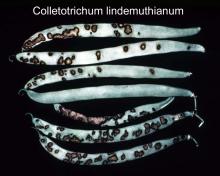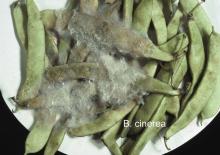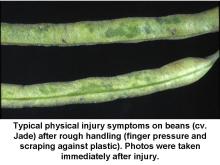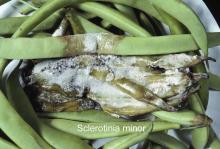Maturity and Quality
Snap beans (yellow, green and purple types) are harvested when they are rapidly growing and developing. Harvest occurs about 8-10 days after flowering for typical mature snap beans. Beans should be harvested when the fruit is bright green, the pod is fleshy and seeds are small and green. After that period, seed development reduces quality and the pod becomes pithy and tough and looses green color.
Beans should be well formed and straight, bright in color with a fresh appearance, and tender but firm. They should snap easily when bent. Leaves, stems, broken beans, blossom remains, insect damage should not be present. Decreased quality during postharvest handling is most often associated with water loss, chilling injury, and decay
Postharvest Handling and Storage
5-7.5°C (41-45°F)
Very good quality can be maintained for a few days at temperatures below 5°C but chilling injury will be induced (see Physiological Disorders). Some chilling may occur even at the recommended storage temperature of 5°C after 7-8 days. At 5-7.5°C (41-45°F) a shelf-life of 8-12 days is expected.
Water loss is a common postharvest problem with green beans. About 5% weight loss is needed before shrivel and limpness are observed. After 10-12% weight loss, the beans are no longer marketable. The weight loss of mature green beans can be estimated from the equation: % weight loss per day = 0.754 x vapor pressure deficit. The VPD can be obtained from a psychrometric chart when temperature and relative humidity are measured. The rate of water loss of immature beans is higher than for mature beans.
| Temperature | ml CO2>/kg·hr | |
| °C (°F) | Snap Beans | Long Beans |
| 0 (32) | 10 | 20 |
| 5 (41) | 17 | 23 |
| 10 (50) | 29 | 46 |
| 15 (59) | 46 | 101 |
| 20 (68) | 65 | 110 |
To calculate heat production, multiply ml CO2/kg·hr by 440 to get BTU/ton·day or by 122 to get kcal/metric ton·day.
Exposure to ethylene at usual storage temperatures causes loss of green pigment and increased browning. Concentrations above 0.1 ppm reduce green bean shelf-life by 30-50% at 5°C.
95-100%
At recommended storage temperature, O2 concentrations of 2-5% reduce respiration rates. Snap beans tolerate and are benefited by CO2 concentrations between 3-10%. The main benefit is retention of color and reduced discoloration on damaged beans. Higher CO2 (20-30%) concentrations can be used for short periods, but can cause off-flavors.
Temperature & Controlled Atmosphere Photos
Disorders
Chilling injury. The typical symptom of chilling injury in beans stored <5°C (<41°F) for longer than 5-6 days is a general opaque discoloration of the entire bean. A less common symptom is pitting on the surface. The most common symptom of chilling injury is the appearance of discrete rusty brown spots which occur in the temperature range of 5-7.5°C (41-45°F). These lesions are very susceptible to attack by common fungal pathogens. Beans can be held about 2 days at 1°C (34°F), 4 days at 2.5°C (36°F), or 8-10 days at 5°C (41°F) before chilling symptoms appear. No discoloration occurs on beans stored at 10°C (50°F). Different varieties differ significantly in their susceptibility to chilling injury.
Freezing injury. Appears as water-soaked areas which subsequently deteriorate and decay. Freezing injury occurs at temperatures of -0.7°C (30.7°F) or below.
Rough handling at harvest or damage from shipping containers can result in translucent areas that are susceptible to decay.
Decay due to various pathogens occurs after beans have been chill damaged. Surface decay may also occur on stems and beans if free moisture is present during storage at >7.5 (>45°F). Common postharvest decay organisms on green beans are the fungi Pythium, Rhizopus, and Sclerotinia, all of which may occur as "nests" of decay or on broken or damaged beans.
Special Considerations
Haricot Verts. Extra careful handling is required for tender immature green beans or haricot verts to avoid physical damage and dehydration.
Long beans have similar postharvest requirements as green beans and similar responses to chilling temperatures. Long beans may yellow more and have more seed development during postharvest handling than snap beans.











